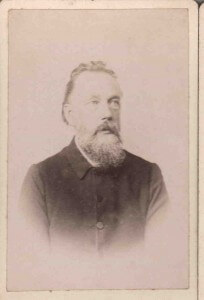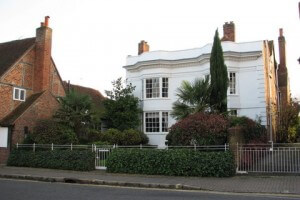These three houses are listed grade II:
Frith House (no.24) was built in the 16th or early 17th century with a later attractive oriel window. William Tothill of Shardeloes left the house early in the 17th century to be used to provide work for poor for women making products from linen. By 1789 the factory had closed and the house was occupied by William Morten, a lace dealer. In 1901 it was described as a “Trimming Factory”, later it became an antique shop and is now a private house. (Hearsay: it is thought that Beatrix Potter visited this house in 1905 when she produced two paintings, copies of which are in the Museum.)
A document given to the Museum shows that in 1955, the damp and woodworm were sufficiently serious that the tenants were advised by Elgar Pike, their estate agent, not to offer more for the freehold than £750!

The Old Forge (no 26) was built in the 16th century and has a large projecting brick chimney. It was still described as a “Blacksmith’s Forge” in the 1901 census, but the head of the house, Mr. Albert Crowhurst, was a “Sanitary Inspector and Veterinary Surgeon”. In 1928 when the Tyrwhitt-Drake family sold the house, it was still described as a “Forge and Smithy” and was let to Mr A. J. Slade, who also rented an adjoining house. Both are probably what is now no. 26. Although the 1928 sale details say that the property was “sold to the tenant”, an agreement has been found under which the actual purchaser was “Mac” Cheese, the solicitor, who gave Mr Slade a year’s tenancy rent-free in return!
The overhanging of the upper floor of this house is called a “jetty”. There are several possible reasons why it was done, although it added to the cost of building as the frame for each floor had to be separately constructed: it added extra space upstairs; it provided some protection from the rain outside the front door; and it stopped the main cross beams from sagging by putting weight on their outer ends to keep them horizontal.
Apsley House (no.28, formerly Alwyns) was built in the late 17th century and re-fronted to be a fashionable town residence in the 18th century with a Queen Anne façade. The older brick chimney can still be seen on the right side of the house.
Below the photo gallery, you can find much more detail about people and dates for these houses.
Click on any of the photographs below to enlarge it and to see the description. Then click on forward or back arrows at the foot of each photograph. To close the pictures, just click on one.
People and dates
No. 24 (Frith House)
1627 Will of William Tothill left £500 and a house and garden in Amersham High Street “for the use to set the poor of Amersham for the time being on work in linnen, the house to be a habitation for the overseer or governor of the said work John Gregory to hold that office”. The original trustees were William Drake, Thomas Saunders, Charles Croke, Heneage Proby and “nine other of the most able and sufficient inhabitants of Amersham”.
1651 “William Rutt, linen Weaver about the year 1651 was placed Governor who improved the stock to £170 who died 1663 and then the power came to Elizabeth Rutt his widow. Montague Drake constituted Gyles Child Governor of the Work without any security who took as his assistant James Norwood.”
1701 Suit in Chancery re Tothill’s Charity. A committee appointed to enquire into the former management of the charity, to make rules and orders for its future management and to settle all accounts and other matters relating to the charity. The committee recommended that the money that they had at their disposal should be used for the repair of the governor’s house and for furnishing it with conveniences and materials for setting the poor to work.
1739 and 1745 Rental by the Trustees of the Workhouse to Mr Wm Child, Steward for a tenement
1746 Letter form Rev John Eaton [Rector of Amersham] to William Drake: “I have made enquiry into the state of the Workhouse here and shall represent it to you as clearly as I am able. William Tothill Esq of Shardeloes gave the house Mr Child lives in and £500 in money A.D. 1627 to set the poor of Amersham on work in linnen work, the house to be an habitation for the workmaster. With part of the money Sir William Drake purchased (1639) a parcel of land in Great Chesham which is now let to Richard Twitchell for £30 a year. There are thirteen trustees appointed (of which the Lord of the Manor of Shardeloes and the Rector of Amersham for the time being are always to be two) and after the death of five and before eight are dead, the survivors are to proceed to an election to fill up the number. The names of the present trustees are William Drake Esq, John Eaton, Henry Moreton sen, Richard Child, Thomas Bayley, George Allnutt, Simon Crane, John Lawrence, John Charsley, John Salter, William Child, Stephen Squier and John Read. The trustees were invested with a power of making rules for the regulation of the workhouse by a decree in Chancery bearing date the 13th of William the third. According to these rules, the workmaster is to have £15 a year salary, to keep the house in good repair himself and to pay all taxes, to give good security for the work which is £200, and to employ what numbers of poor the trustees think fit to send, and to pay them for their work at least the prices following viz: One fathing for every hundred rounds on the wheel, to three turners three pence a day each, and to six spinners twelve pence a chain. John Jennings, the present workmaster gave bond for stock jointly with John Maycock and Thomas Claydon. Maycock is supposed to be very poor, Claydon is dead and one Harding (who was his heir) is dead likewise and the effects are come late into the hands of a poor old woman and her son, for whom Mr Squier and Read are trustees, and they think the security now very bad. Upon any dislike, the workmaster is to quit his place upon a year’s notice given in writing, and accordingly Jennings had notice given him by order of a majority of the trustees some time before last Michaelmas either to give better security or turn out. They complain that he has not yet mentioned a word about further security and therefore they think he ought to be displaced if he does not comply with the rules.”
1789 Letter from Thomas Marshall to William Drake Esq “I have settled the account between Fisher and the Trustees of the Linnen Workhouse and the former has given up the shop etc in consequence of which a meeting of the Trustees was appointed to be held at my house on Friday last to dispose of the manufactory and three different proposals by inhabitants of the parish were then made for carrying on (viz) one by Messrs John Hailey, Richard Morris and Thomas Hailey, another by James Stone the collarmaker and the other by a person of the name of Hatch all on different plans; but there being only three out of the Trustees present, namely Dr Drake, Mr Salter and Mr Allen, those gentlemen thought the business of too much consequence to be determined by them alone….. As the manufactory is now in suspence, I imagine the Trustees would wish to come to some conclusion about it as soon as possible …..”
1816 Rental byTrustees of Mr Tothill’s Charity for a house in the High Street in the occupation of Mr Wm Morten.
1833 Charities Report on Tothill’s Charity: “House and garden in the town of Amersham, let to the widow of William Morton, lately deceased (who held it for many years) as yearly tenant at a rent of £12 p.a.”
1841 Census: Henry Boddy (30), cordwainer [a maker of fine shoes]
1851 Census: Henry Boddy (41) cordwainer, 2 men
1891 Census: Robert Gomm (45) Omnibus proprietor
1910 Valuation: Trustees of Tothill’s Charity: Mrs Gomm House, shop
1952 Directory: Hinkley, Mrs Annie greengrocer & fruitrerer
No. 26 (The Old Forge)
1674 A tenement of Mary Newman widow now or late in tenancy or occupation by Ralph Hobbs on the West.
1696 Assessment Ralph Hobbs for his house and for his own land
1765 Window Tax: John Miles
1781 John Miles of Amersham in Bucks ironmonger & blacksmith insured with Sun Insurance “ his household goods in his now dwelling house only situate as aforesaid, brick plaister & tiled, wearing apparel, utensils & stock therein for £300
1798 Posse Comitatus (list of able-bodied men who could be conscripted): Blacksmiths John Miles
1839 Tithe Award: Owner: Thomas Tyrwhitt Drake, Occupiers: Thomas Nathaniel Gray, Joseph Beeson
1841 Census: Joseph Beeson (34) veterinary surgeon
1851 Census: Joseph Beeson (44) Veterinary Surgeon
1862 Article by Kelke “The house now occupied by Mr Beeson…. contains an old fireplace, and the square-headed windows have large stone mullions”
1869 Directory: Private Residents: Beeson, Joseph, High Street
1881 Census: Eustibus Crowhurst (47) veterinary surgeon
1891 Directory Crowhurst, Albert B veterinary surgeon & sanitary inspector
1907 Directory Crowhurst, Albert B veterinary surgeon & sanitary inspector to Rural District Council
1910 Valuation Drake W W T: Rance, A B House & Forge High Street
1952 Directory Templeman, Constance Ltd antique dealers, The Old Forge
.
28 High Street (Apsley House)

1739 Rented by Wm Drake Esq to The Rev Mr Robertshaw or Mrs Hughes for a messuage and orchard 1 1/2 acres yearly Rent £13 0 0
1765 Window Tax Mrs Manby, 19 windows
1783 Land Tax Wm Drake Esq: Thomas Brickwell
1798 Posse Comitatus (list of able-bodied men who could be conscripted): Surgeons,Thomas Brickwell
1830 Directory: Gray, Thomas Nathaniel, surgeon
1841 Census: Thomas Gray (45) surgeon
1851 Census: Thomas Nathaniel Gray (57?) General practitioner
1891 Census: Apsley House William Fisk (56), Baptist Minister
1901 Census: Mrs Eliza Clarke (63), journalist and author, and Miss Lucy S Clarke (32)
1903 Directory: Mrs Clarke, Apsley House, High street
1910 Valuation: owner W W T Drake, tenant A W S Cochrane, Alwyn House
1911 Directory: Cochrane, Arthur, Alwins High Street
1915 Henderson, Henry John M.B., Alwyns (awarded the Military Cross in WWI)
1924 Henderson, Henry John M.C. M.B. Alwyns; Henderson & Green physicians & surgeons Alwyns
1931 Henderson, Henry John M.C. M.B., Alwyns
1939 Directory Henderson, Henry John Alwyns, High Street
1952 Directory Keeble, George A, Apsley House










